In 1776, the “old money” families in New York – the ones that had been around in Dutch times and had continued to thrive for a century under the British – were the Van Rensselaers, the Van Cortlandts, and the Schuylers. Angelica’s parentage was a trifecta: a Schuyler married to a Van Rensselaer, with Van Cortlandts for paternal grandmother and maternal step-grandmother.
Papa Schuyler
Philip Schuyler (1733-1804), Angelica’s father, was elected to the Second Continental Congress in 1775, and soon afterward was appointed a major-general in the Continental Army. After the Revolutionary War, he became one of New York’s first senators, 1789 to 1791. Bumped out of office by Aaron Burr, Schuyler returned to the Senate from 1797 to 1798.
Mansions built by Philip Schuyler still stand in Albany and Saratoga. His daughters would have had quite a long commute to go “slumming it with the poor” in Manhattan … But hey, you can’t keep the kids home on the farm forever.
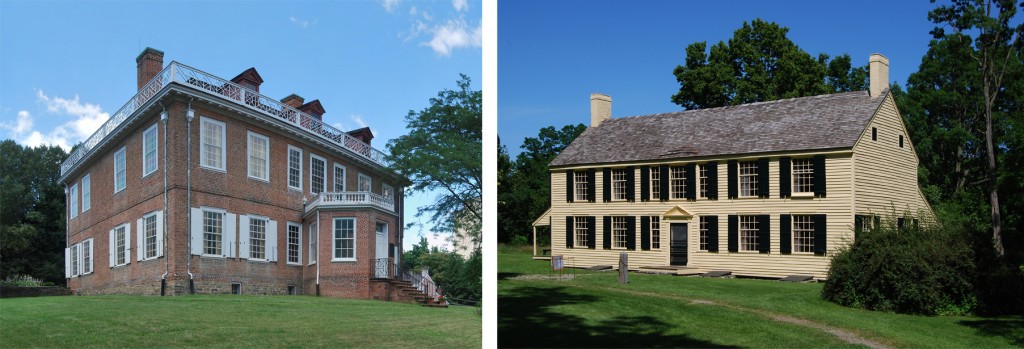
Mama Schuyler
Angelica’s mother, Catherine Van Rensselaer Schuyler (1734-1803), bore 15 children: five daughters and three sons survived to childhood. Family tradition said that in 1777, when British troops were marching toward the family’s country home in Saratoga, Mama Schuyler torched the wheat fields to deny them food. In 1852 Emanuel Gottlieb Leutze, whom you jolly well ought to know for his Washington Crossing the Delaware, painted Mama Schuyler as an incendiary patriot. He based her face on a portrait now at the New-York Historical Society. No documentation has been found to support the family tradition – but it makes for a charming picture.
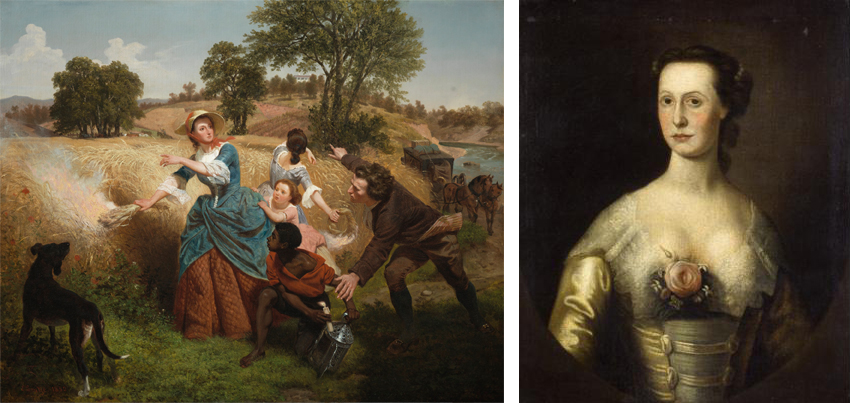
Angelica’s marriage
Angelica, the eldest Schuyler child, was born in 1756 – a year or so earlier than Alexander Hamilton, if you accept 1757 as the year of his birth. By all accounts, Angelica’s intelligence, beauty, wit, and charm were remarkable. But this isn’t an era when being the wittiest and prettiest girl in the room would get you noticed, if the room you were in was a pauper’s hovel. In fact, during the eighteenth century – before the Industrial Revolution, before the rise of capitalism and corporations, when divorce meant social disgrace – the usual way to seal a merger of fortunes was by a marriage. Angelica’s parents would have expected their children to marry people they approved of, who would enhance or at least preserve the family’s status and/or wealth.
Angelica circumvented that expectation by eloping in 1777 with John Barker Church (1748-1818), an Englishman who made a fortune as a supplier to the Continental and French armies. (Mama Schuyler refused to meet Angelica and John until the grandparents intervened.) Soon after the Revolutionary War ended, Church was sent as U.S. envoy to France (1783-1785). Angelica and her family moved to Paris, where she became friends with Benjamin Franklin, Thomas Jefferson, and the Marquis de Lafayette. Later the Church family relocated to London, where John was elected to Parliament. Except for a brief visit in 1789, to see Washington’s inauguration as first president of the United States, Angelica’s family lived in Europe until 1797.
Here she is with her son in 1785, painted by John Trumbull, whom you jolly well ought to know for his Declaration of Independence, his Washington Before the Battle of Trenton, and his Surrender of Lord Cornwallis at Yorktown (in which Alexander Hamilton makes a profile appearance).
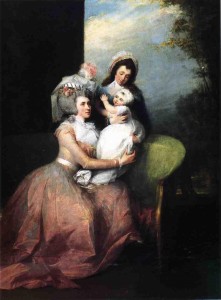
In 1799, John Barker Church became one of twelve founding directors of the Manhattan Company. The ostensible purpose of the Company – which was the brainchild of Aaron Burr – was to bring fresh water to Manhattan. But through a loophole in the legislation, the directors intended to create a bank that would be in direct competition with the Bank of New York, which Hamilton had helped establish in 1784 (now BNY Mellon; see this earlier post). The water never flowed, but the bank survived and (mostly) prospered, evolving into Chase Manhattan and then J.P. Morgan Chase. Later in 1799, Church accused fellow-director Burr of taking bribes. The two dueled in Weehawken. Both emerged unscathed. The oft-repeated story that they used the same pistols as Burr and Hamilton fired five years later is apparently not true.
Angelica’s intellect
I love seeing Angelica in that painting … but what sort of mind did she have? What did she think and say?
Unfortunately, few of her letters have survived. Among those I’ve seen, my favorite is this one, written to Eliza from London on 7/30/1794.
I have a letter my dear Eliza from my worthy friend M. de Talleyrand who expresses to me his gratitude for an introduction to you and my Amiable, by my Amiable you know that I mean your Husband, for I love him very much and if you were as generous as the old Romans, you would lend him to me for a little while, but do not be jealous, my dear Eliza, since I am more solicitous to promote his laudable ambition, than any person in the world, and there is no summit of true glory which I do not desire he may attain; provided always that he pleases to give me a little chit-chat, and sometimes to say, I wish our dear Angelica was here. Talleyrand and Beaumetz write in raptures to all their friends of your kindness, and Colonel Hamilton’s abilities and manners, and I receive innumerable compliments on his and your account.
Ah! Bess! you were a lucky girl to get so clever and so good a companion.
Mr Jay has been perfecctly well received at Court and by the Ministers, as yet no material business is done. The people are anxious for a peace with America, and the allied armies are beat out of Flanders and on the Rhine. These circumstances may determine the Minister to be just and wise. Mr. Jay dined with Mr. Fox at our house a few days after his arrival.
Mr. Morris is building a palace, do you think Monsieur l’Enfant would send me a drawing of it? Merely from curiosity, for one wishes to see the plan of a house which it is said, will cost, when furnished 40,000 pounds Sterling. [Quoted in An Intimate Life of Alexander Hamilton, by Allan McLane Hamilton; it’s not clear whether this is the entire letter]
This is the letter paraphrased in Hamilton: An American Muscial as, “If you really loved me, you would share him.” It’s one of the pieces of evidence most frequently cited by those who believe Angelica and Alexander had an affair. There is no indisputable evidence of such an affair. It’s worth noting, too, that this letter wasn’t written in 1780, when Alexander and Eliza met and married, but fourteen years later. … As a historian, I suppose I ought to present you with all the evidence and balance all the possibilities. As a woman, I simply can’t imagine Angelica – who was close friends with Eliza all her life (there is plenty of evidence of that) – jumping into bed with Alexander, at the risk of losing both Eliza and Alexander. Done talking about that now. (Or not: see Hamilton Musical posts 53 and 59.)
Let’s get back to the rest of the letter. Angelica displays an impressive knowledge of politics and culture. The “Mr. Jay” who dined at her home was the same one who collaborated on The Federalist Papers with Hamilton and Madison (see Hamilton Musical posts 52 through 57). He was in London negotiating what became known as “Jay’s Treaty,” which settled significant disputes between the United States and Great Britain over military occupation, debts, and trade.
The Mr. Morris who was building a palace was financier Robert Morris, who signed the Declaration of Independence and the Constitution. Morris turned down Washington’s offer of the position of secretary of the Treasury, and recommended Hamilton for it. (See Hamilton Musical post 31.) Morris’s enormous mansion in Philadelphia, filling the entire block between Walnut, Chestnut, 7th, and 8th Streets, was left incomplete when he went bankrupt a few years later. L’Enfant, whom Angelica mentions with casual familiarity, later designed the plan for the city of Washington, D.C.
All this political and social savvy was displayed in a letter to her sister – not intended for publication or meant to impress. You want to see a mind at work, look at Angelica.
Angelica and Thomas Jefferson
More letters survive to Angelica than from her – and the letters to her were written by luminaries. This one from Hamilton, dated 12/6/1787 (part of a much longer letter) has also fueled discussions about their possible affair:
I seldom write to a lady without fancying the relation of lover and mistress. It has a very inspiring effect. And in your case the dullest materials could not help feeling that propensity. I have a great opinion of your discernment and therefore I venture to rant. If you read this letter in a certain mood, you will easily divine that in which I write it.
But Thomas Jefferson seems to have been equally enamored of Angelica. After she visited him in Paris, he wrote on 2/17/1788:
The morning you left us, all was wrong, even the sunshine was provoking, with which I never quarreled before. I took it into my head he shone only to throw light on our loss: to present a cheerfulness not at all in unison with my mind. I mounted my horse earlier than common. I took by instinct the road you had taken. … I think I have discovered a method of preventing this dejection of mind on any future parting. It is this. When you come again I will employ myself in finding or fancying that you have some faults. & I will draw a veil over all your good qualities if I can find one large enough.
The Marquis de Lafayette wrote lengthy epistles to Angelica. George Washington, too, was on quite good terms with her: see his letter of 12/4/1798 (recently disappeared from the Net). Personally, I’m inclined to make allowances for the effusive prose style of the eighteenth century, rather than assuming Angelica rolled into bed with all those fond Founding Fathers.
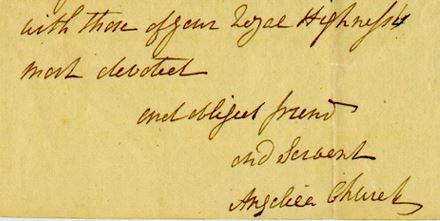
More
- This site claims that Angelica is buried in Trinity Churchyard, not far from Alexander Hamilton – but some guides at Trinity Church say not. HT to Carrie-Ann Biondi for letting me know that.
- For an example of the convoluted Van Rensselaer / Van Cortlandt / Schuyler relationships, see the provenance of this elegant 17th-century teapot, which may be the earliest surviving teapot to have been made in New York. It belonged to Angelica’s mother, so let’s go right ahead and imagine Angelica drinking tea poured from it.
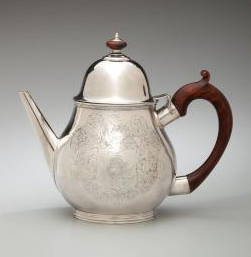
- For information on Angelica’s mother and father, I’ve treated the entries in the American National Biography as definitive: it’s certainly more reliable than Wikipedia. On the other hand, how can the article on Hamilton not cite Chernow’s biography of Hamilton (2004) or Michael Newton’s extraordinarily thorough work on his formative years (2015)? The Oxford University Press (which runs ANB) needs to set a repeating GQueues reminder to tell its scholars to update their articles.
- The most cohesive account of Angelica’s correspondence that I’ve seen is on this WordPress site. I do wish someone would proof that page and add the missing spaces. (Cranky today, aren’t we?)
- The University of Virginia recently bought from Angelica’s descendants a treasure-trove of letters to her, some of which are cited above. The page for the exhibition “Muse and Confidante” includes links to images of many of the letters. This charming fangirl blog post has yet more images.
- Angelica was introduced to Jefferson by Maria Cosway, a mutual friend. I had never heard of Cosway until I saw a 2014 production by Salon-Sanctuary, “More Between Heaven and Earth: Thomas Jefferson, Maria Cosway, and the Music and Philosophy of the Enlightenment.” It was held at the reconstructed Fraunces Tavern, and it was exceedingly enjoyable. If you’re a fan of 18th-century prose style and music, get your name added to the mailing list for Salon-Sanctuary, in case they do a reprise, or set up a Google alert. I only heard of it because I know the people who did the jaw-droppingly beautiful costumes.

- I’ve occasionally added comments based on these blog posts to the Genius.com pages on the Hamilton Musical. Follow me @DianneDurante.
- The usual disclaimer: This is the twelfth in a series of posts on Hamilton: An American Musical. Other posts are available via the tag cloud at lower right. The ongoing “index” to these posts is my Kindle book, Alexander Hamilton: A Brief Biography. Bottom line: these are unofficial musings, and you do not need them to enjoy the musical or the soundtrack.
- Want wonderful art delivered weekly to your inbox? Check out my free Sunday Recommendations list and rewards for recurring support: details here.

